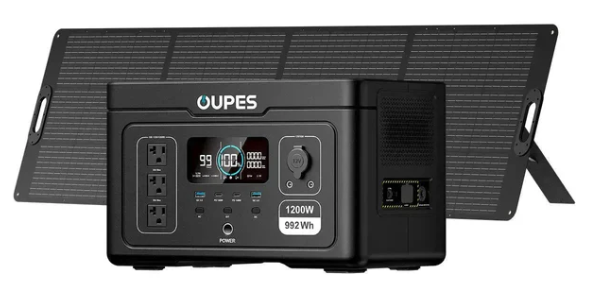
Overview
Solar power has become one of the fastest-growing energy sources in the United States, driven by falling installation costs, supportive policies, and heightened demand for clean energy. But which state generates the most solar power? Using data from the U.S. Energy Information Administration (EIA) and the Solar Energy Industries Association (SEIA), this article breaks down the leaders, the reasons behind their success, and how portable solar technologies such as solar generators and power stations—including those offered by brands like OUPES—fit into the broader U.S. solar landscape.
Solar Power Growth in the U.S.
Solar Is Now a Major Power Source
According to SEIA, solar energy accounted for more than 50% of new electricity-generating capacity added in 2023, making it the largest contributor to new U.S. power infrastructure. Total installed capacity now exceeds 160 gigawatts, enough to power over 28 million homes.
Reasons for Rapid Expansion
- Declining panel and battery costs (over 80% decrease in the last decade)
- Federal tax credits, including the 30% Investment Tax Credit (ITC)
- State-led incentives, renewable portfolio standards, and net metering policies
- Growing demand for energy resilience and backup power solutions
Top Solar-Producing States
Based on the latest EIA and SEIA data, the state that produces the most solar power is California, followed by Texas and Florida.
1. California — The Solar Power Leader
California generates more solar power than the next several states combined. With abundant sunshine, strong renewable incentives, and large-scale solar farms in the Mojave Desert, the state produces more than 30% of the nation’s total solar electricity.
2. Texas — Rapidly Growing Utility-Scale Solar
Texas has become the second-largest solar producer, largely due to vast land availability and major investment in large utility-scale photovoltaic farms. The state frequently leads the nation in new annual installations.
3. Florida — The “Sunshine State” Rising Fast
Florida ranks third, driven by growth in both residential and utility-scale solar projects. Strong solar potential and supportive policies have pushed major capacity expansion.
4. Arizona — High Solar Irradiance
With some of the best solar irradiance in the world, Arizona consistently ranks among the top states for solar generation, especially for utility-scale installations.
5. North Carolina — A Southeastern Solar Hub
North Carolina leads the southeast in solar deployment and has remained in the national top five for several years, driven by significant commercial and utility-scale investments.
Comparison of Solar Power by State
This table summarizes annual solar generation for the top-producing states (EIA 2023 data):
| State | Annual Solar Generation (GWh) | Key Strengths |
|---|---|---|
| California | ~50,000 GWh | Strong incentives, solar farms, high adoption rate |
| Texas | ~25,000 GWh | Large land area, utility-scale growth |
| Florida | ~15,000 GWh | Excellent sunlight, growing utility projects |
| Arizona | ~13,000 GWh | High irradiance and desert solar farms |
| North Carolina | ~8,000 GWh | Strong commercial and utility investments |
Why Certain States Lead in Solar Generation
1. Solar Irradiance Levels
Sun-rich states—particularly in the Southwest—naturally generate more solar electricity. Arizona, Nevada, and California receive some of the highest irradiance levels in the world.
2. State Policies and Incentives
States with aggressive renewable energy goals or strong net metering programs tend to achieve higher solar capacity.
3. Land Availability
Texas, California, and Florida have vast open land suitable for large-scale photovoltaic installations.
4. Energy Costs and Demand
High electricity prices encourage more homeowners and businesses to invest in solar. California is a prime example, where solar adoption has been propelled by rising utility costs.
5. Population Density and Market Adoption
States with large populations provide bigger markets for residential solar, contributing to installation growth.
The Role of Portable Solar Generators in Solar Growth
Portable Solar Generators as Personal Energy Solutions
While utility-scale solar dominates state rankings, portable solar generators and power stations represent one of the fastest-growing consumer solar categories. These devices allow individuals to generate and store solar energy anywhere, making solar more accessible to renters, RV travelers, campers, and emergency-preparedness users.
Backup Power During Outages
With the increase in weather-related grid failures, many households supplement rooftop solar with portable power stations. Brands such as OUPES provide battery-based solar generators capable of powering home appliances, communication devices, and lighting during blackouts.
Expanding Solar Access Beyond Homeownership
For people who cannot install rooftop solar, portable generators provide a flexible, low-barrier entry into solar energy use.
The Future of U.S. Solar Energy
Continued Growth Expected
SEIA forecasts that U.S. solar capacity will triple over the next decade, driven by new federal and state incentives, declining costs, and increased battery storage deployment.
Wider Adoption of Energy Storage
Whether through home batteries or portable storage systems, energy storage will play a pivotal role in balancing solar supply and demand, reducing curtailment, and improving grid stability.
More States Rising to the Top
While California currently leads by a wide margin, states like Texas and Florida are adding new capacity at record pace and may challenge the ranking as utility-scale projects accelerate.
FAQ
1. Which state currently generates the most solar power?
California leads the nation by a significant margin, producing more than 30% of all U.S. solar electricity.
2. Why is Texas growing so quickly in solar power?
Texas has abundant land, strong solar resources, and large-scale investment in utility-scale solar farms, making it one of the fastest-growing solar states.
3. Does the “Sunshine State” (Florida) produce the most solar?
Despite its nickname, Florida ranks third; however, it is rapidly expanding residential and utility solar.
4. How do portable solar generators contribute to solar power adoption?
Portable solar generators allow consumers to use solar energy without installing rooftop systems, supporting energy independence and emergency preparedness.
5. Are states with high sunlight always the top solar producers?
Not always. Policies, incentives, and investments play a major role. For example, North Carolina ranks high due to commercial solar development despite lower irradiance than Arizona.
6. Will solar continue to grow nationwide?
Yes. Federal incentives, lower costs, and high demand for clean energy suggest rapid solar expansion through the next decade.




























